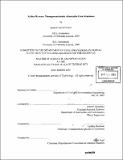| dc.contributor.advisor | Peter P. Belobaba. | en_US |
| dc.contributor.author | Cusano, Andrew Jacob, 1978- | en_US |
| dc.contributor.other | Massachusetts Institute of Technology. Dept. of Civil and Environmental Engineering. | en_US |
| dc.date.accessioned | 2005-09-06T20:43:48Z | |
| dc.date.available | 2005-09-06T20:43:48Z | |
| dc.date.copyright | 2003 | en_US |
| dc.date.issued | 2003 | en_US |
| dc.identifier.uri | http://hdl.handle.net/1721.1/26900 | |
| dc.description | Thesis (S.M.)--Massachusetts Institute of Technology, Dept. of Civil and Environmental Engineering, 2003. | en_US |
| dc.description | Includes bibliographical references (leaves 119-120). | en_US |
| dc.description.abstract | Airline revenue maximization consists of two main components: pricing and revenue management. Revenue management systems are used to control seat inventory given a forecasted demand to maximize revenues. Fare structures have been constructed by major network airlines to segment demand with multiple fare products and numerous restrictions, a practice known as differential pricing. The increasing presence of low-cost carriers with simplified fare structures (compressed fare levels and fewer booking restrictions) combined with recent market demand shifts have led some major network carriers to explore the use of simplified fare structures. This research examines the performance of revenue management systems under these alternative fare structures as compared to the performance of these systems with the traditional fare structure. The objective is to measure the impacts on overall revenue and revenue management under alternative fare structures. The Passenger Origin-Destination Simulator (PODS) is used in this research to test the impact on revenue management of alternative fare structures. Results show that alternative fare structures lead to overall revenue reductions. The magnitude of reduction is as high as 20 percent when all fare restrictions are removed compared to the traditional base case fare structure. However, leg-based fare-class revenue management still produces a large revenue gain, up to 17 percent, over a first-come-first-serve regime regardless of the fare structure used. Furthermore, incremental revenue gains from origin-destination control as opposed to fare-class revenue management are still present with alternative fare structures. The incremental revenue gains are greater than 1 percent in all cases and greater than 3 percent when advance purchase requirements are removed. In the case when all restrictions are removed, origin-destination control actually performs better at a given network average load factor than with a traditional fare structure. | en_US |
| dc.description.statementofresponsibility | by Andrew Jacob Cusano. | en_US |
| dc.format.extent | 120 leaves | en_US |
| dc.format.extent | 7415967 bytes | |
| dc.format.extent | 7430806 bytes | |
| dc.format.mimetype | application/pdf | |
| dc.format.mimetype | application/pdf | |
| dc.language.iso | en_US | |
| dc.publisher | Massachusetts Institute of Technology | en_US |
| dc.rights | M.I.T. theses are protected by copyright. They may be viewed from this source for any purpose, but reproduction or distribution in any format is prohibited without written permission. See provided URL for inquiries about permission. | en_US |
| dc.rights.uri | http://dspace.mit.edu/handle/1721.1/7582 | |
| dc.subject | Civil and Environmental Engineering. | en_US |
| dc.title | Airline revenue management under alternative fare structures | en_US |
| dc.type | Thesis | en_US |
| dc.description.degree | S.M. | en_US |
| dc.contributor.department | Massachusetts Institute of Technology. Department of Civil and Environmental Engineering | |
| dc.identifier.oclc | 54516306 | en_US |
